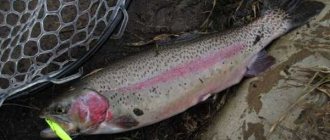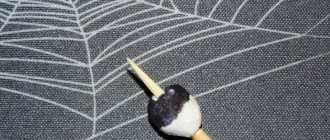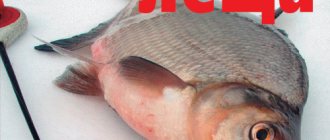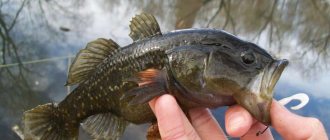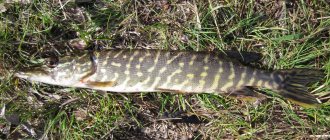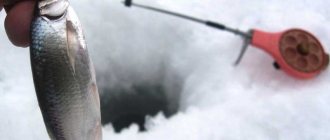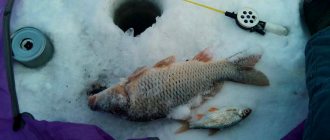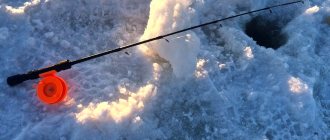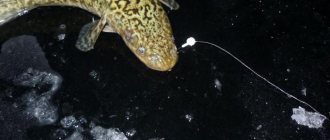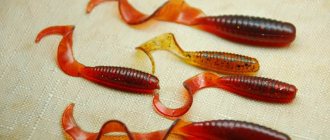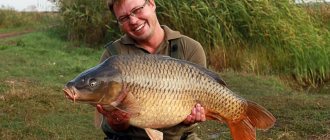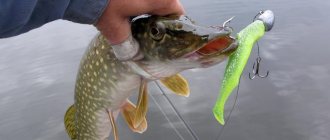In some regions, catching bream with lard is a common occurrence, but in others such a bait is surprising. Various fish are used for lard - rotan, ide, chub, roach. But it is precisely for bream and crucian carp that this bait sometimes shows amazing results. In this article we will look at the features of fishing for bream with lard, the gear used and the requirements for bait.
What kind of fish are caught with lard?
In domestic reservoirs, almost all fish of the carp family react with great pleasure to this high-calorie bait. The exception is fish, whose oral cavity is very poorly developed. Therefore, bream, carp, crucian carp, ide, tench, rudd, roach and even catfish are successfully caught using lard. With the arrival of cold weather, nutritious baits become much more attractive to the underwater inhabitants of domestic reservoirs.
Almost all carp fish bite on lard
How to choose lard for fishing
The success of fishing for lard depends on the quality of this product. As bait, fishermen use lard, both salted and not, both with and without veins.
Lard can be salted or not, with or without streaks
It depends on the taste preferences of the fish. For example, when fishing for catfish, anglers recommend using slightly smoked lard along with the skin. And, when fishing for carp, it is best for the lard to have a garlic flavor. But the main fishing requirement for lard is its density. The piece should stay well on the hook and not fly off it.
Preparing lard bait
The fish need to be interested, and for this you need to prepare the “right” bait. Let's consider several options:
- cut the organic product into small cubes (2-5mm). The rule here is: the larger the fish, the larger the size of the bait;
- By cutting off the corners on squares of fatty tissue, you can give them a round shape, making it a catchable bait. Many fish are actively caught using baits of this shape, for example, representatives of the order of carp or bream fish;
- You can make a bait from lard that imitates maggots by cutting this product into strips. It is successfully used by fans of bottom and feeder fishing. Such attachments should be mounted on a fishing hook in groups of three or more;
- The greasy bait can be flavored by adding a little garlic, cinnamon, cloves or pepper. Sweet smells are unlikely to work well and will likely scare away the fish. Finding out which spray is more effective will most likely have to be done experimentally right on the pond.
Read: How to store worms for fishing at home, what to feed them and how to grow them
Preparing for fishing
Although no special additional processing is needed for lard, it should be prepared a little before fishing. To do this, slightly frozen lard needs to be cut into cubes of a suitable diameter, which depends on the size of the expected trophies. You also need to consider whether you plan to combine pieces of lard on the hook with maggots or bloodworms. To catch large crucian carp or crucian carp, the lard should be cut into cubes of 1*1 cm, for catching roach into 0.5*0.5 cm.
The size of the cubes depends on the expected size of the trophies
There is no need to cut the entire piece of lard into pieces; it may happen that upon arrival at the pond, it becomes clear that pieces of other sizes are needed.
Fishing for lard with a fishing rod and float
The technique of this fishing is not complicated, but it also has its own specifics. This fishing option is suitable for fishing for roach, crucian carp, carp and bream, as well as other fish of the maroon family. Catching crucian carp with a float rod using lard promises to be especially successful.
It is better to use a sports float when the fishing line is attached in two places. This design perfectly conveys any movement of the hook and makes it possible to clearly observe bites even in windy weather. The diameter of the main line is no more than 0.2 mm, and the leader - 0.14 mm. The hook must be sharp and strong so that during hooking it can easily penetrate the thickness of the greasy piece.
A fishing rod with a float baited with pieces of lard is great for catching large crucian carp.
When fishing with lard using a float rod, it is a good idea to add pieces of it to your complementary foods. You can use both salted and unsalted lard. But salt should be in moderation. It can activate the bite, but its excess can drive all the fish away from the bait.
Fishing bream for lard in summer
As already mentioned, streaky lard is most suitable for catching bream; it is best if it is unsalted.
To prepare such a catchable bait,
the lard must be frozen, and then cut off the skin from the frozen piece, under which is the very layer required for the bait.
Having cut off the desired layer, you need to chop it into small cubes, about 5 mm in size. These cubes can be placed in a bag and frozen before your fishing trip. Pieces of frozen lard can be used as a bait without unnecessary aromatic additives, on their own.
Pure lard attracts bream no worse than flavored lard. But if the need arises to use a specific flavor, you need to remember that you should choose from animal-based flavors so that they blend harmoniously with the natural smell of lard.
Many fishing enthusiasts use so-called sandwiches as bait, combining lard with maggots, bloodworms and worms. The first option is good for autumn fishing, but the others are best used in the cold season.
In the summer season, it is difficult to fish for bream for lard due to the heat, which prevents the effective storage of the bait. To prevent lard from spoiling, you can use a plastic bag and newspaper as a thermos. You can also place lard in a glass jar with salted water and bury it in the ground on the shore.
Many years of experience of fishermen suggests that this storage method is best suited and can significantly increase the catch. In summer, it is best to catch bream on a feeder, where the feeder also serves as a sinker. This is precisely the difference between the chosen tackle and the classic donkey.
Complementary feeding can begin immediately after choosing a suitable place for fishing. To do this, you will need to cast the fishing rod several times without bait.
Steamed porridge or boiled peas work well as bait for bream. But it would be best to use special bait that does not need to be aromatized with too strong odors, this will scare away the bream.
Since bream has a sweet tooth, sugar should be added to its bait. Fishermen at competitions add not simple sugar to their bait, but concentrated sugar, which has a much sweeter taste. Among the aromas, bream really like fruity and caramel aromas.
The success of fishing largely depends on the quality of the bait. In principle, fishermen use salted or unleavened lard, with or without streaks, with the addition of various flavorings such as pepper or garlic, and so on.
The choice of bait directly depends on the taste preference of the fish. The fact is that bream is picky in terms of its choice of food, so one day it can take lard with the smell of garlic, and the next it will give preference to ordinary unleavened lard.
As mentioned earlier, lard is first cut into small pieces. Their dimensions should be approximately 0.5x0.5 cm. They immediately think about whether this bait will be combined with maggots or bloodworms.
It is absolutely not necessary to cut the entire piece of lard, because it is possible that after you start fishing, pieces of other sizes - larger or smaller - will be more suitable. It is advisable that the lard be as fresh as possible.
The main difficulty in the summer is to keep the lard fresh and prevent it from spoiling. Experienced fishermen recommend doing the following: put it in a small jar filled with water with a small amount of salt, and bury it in the ground near the coastline.
This method allows you not only to keep the bait intact, but also to make it emit an additional smell, which will lure the fish even more strongly.
Despite the fact that bream takes lard quite actively, you should select the right tackle. For coastal fishing, it would be most ideal to use a float rod with a blind rig. The length of the tackle should be in the range from 6 to 9 meters, the action should be hard or medium.
When the habitats of bream are located quite far from the shore, you can use a special Bolognese fishing rod, the design of which includes a special reel. Thanks to it, you can cast bait quite far.
When the bream takes the bait, it makes a lateral movement - it is at this moment that it should be hooked. Bream is one of the deep-water fish, so it is worth bringing it to the surface as quickly as possible, then, due to decompression, it will practically stop resisting, lie on its side and allow itself to be calmly picked up and removed from the hook.
In order for the fish to take as actively as possible, lard can be placed on the hook along with a worm, corn or other kind of bait that the bream likes in one way or another.
Fishing for lard using bottom tackle
This equipment is usually used when catching large fish, so the lard must be cut into pieces 1*1 cm. The aromatic lard on the hook will attract the attention of large carp, bream, tench, ide, catfish and other fish. Installation of this equipment exists in the following options:
- without a feeder, on a leash;
- on several leashes with a feeder.
Bream fishing
Bream are caught using lard using open or semi-closed feeders using several leashes. Place pieces of lard on the hook as carefully as possible, hiding the tip of the hook in the lard piece. Otherwise, the fish may get stuck and will no longer swim in the bait. Also, the hook should be as sharp as possible so that during hooking it can easily pierce the fat, plunging into the fish’s mouth.
Lard is one of the best baits for catching bream.
In addition to the main bait, which is loaded into the feeder, it is also recommended to additionally use bait balls. Which should contain boiled rice. Bream is also caught using lard and garlic. But due to the fact that the tastes of fish are changeable, it is ideal to have both bait options with you.
Catching catfish
Separately, it is worth talking about catching catfish with lard using bottom gear. When fishing for catfish, hooks should be large, which means the pieces of lard should be larger than even 1*1 cm. Ideally, the lard should have veins and have a smoky aroma. Feeders are not used to catch catfish; one large piece of lard on a hook is enough.
Also, despite the fact that catfish have fairly sharp teeth, they are not able, like pike, to bite through fishing line, so leashes will also not be needed.
Fishing for bream with bottom tackle
On average, caught bream weigh from 1 to 3 kg, but trophy specimens can weigh up to 5 kg. From this we can conclude that bream cannot be called a heavy fish, but the tackle for fishing it must be sufficiently strong and rough.
To catch bream with lard, a half-bottom can be used, which is especially relevant in early spring, during high water. Catching bream with a float rod at this time of year is inconvenient, because the current is too strong, and an ordinary donka will not bring the desired result due to the fact that bream prefers to stay near the coastline this season.
The main line for the half-bottom should be 0.3 mm.
in diameter, and the thickness of the leads should not exceed 0.17 mm.
The average weight of bream ranges from one to three or four kilograms, but quite large specimens can be caught, weighing five kilos or even more. In principle, it is clear that bream is far from the largest fish that lives in the waters of the middle zone, and moreover, it is not very strong.
However, bream fishing tackle should be as durable as possible. It is very convenient to use the so-called half-bottom, on which fish actively bite in the spring months, especially immediately after the ice melts or during high water. The fact is that fishing during this period using a float rod is inconvenient due to the fairly strong current.
It is also difficult to use an ordinary bottom fish at this time, since it is effective in deep water, and bream during this period comes close to the coastline. The maximum thickness of the fishing line for this gear is about 0.4 mm, the leashes are taken even thinner - no more than 0.17 mm, thicker gear will scare away this cautious fish.
By using a thin fishing line, you don’t have to worry about it being carried away by the current. It usually does not have high tensile strength, but this is easily compensated for by the flexible rod.
When using lard as bait, donka is used much more often compared to other gear. These products are not only very catchy, but also very simple and cheap, and they can also be assembled right on the shore from scrap materials.
The tackle often has springs with bait, the maximum weight of which should be about 20-40 grams. This factor is taken into account when choosing a fishing rod, the length of which, in principle, does not play a special role.
It is best to take the most elastic tackle so that it can properly work out the sudden movements of the fish, otherwise the bream that bites will be removed from the hook and leave.
You can take the cheapest reel, since you won’t have to cast the bait in the depths of the reservoir. If you catch bream with lard, you won’t have to cast bait too often; most of the time is spent waiting for the fish to bite. In this regard, even a spinning reel is quite suitable.
In principle, a bottom fishing rod should consist of the following elements:
- A spring with good capacity, and it must also have its own load;
- Carabiner equipped with a swivel;
- A thin leash, at one end of which there should be a hook. The length of the leash is selected to be no more than 10 cm so that it is located close to the spring.
When catching bream using bottom tackle, self-hooking often occurs, so the hooks are taken as strong as possible. In principle, fairly large hooks are suitable, as they will scare away small individuals.
It is best to choose a float fishing rod with a blind rig, medium or hard action and a length of 6-9 m. The length of the fishing line should be enough to cast over a distance of 30 meters, while its diameter should be from 0.16 to 0.2 mm . In many ways, the success of catching this fish depends on the correct choice of float, since you will need to notice the bite in time.
The bream bites quite characteristically; before taking the bait, it turns over on its side and the float moves in the same way, only after that it sinks. You need to hook exactly when the float is on its side, so that at the most crucial moment the bream does not spit out the bait.
